| Ships of Plan Z:
The Torpedo Boats
By Mike Bennighof, Ph.D.
July 2023
 The term “torpedo boat” fell out of use in most navies just before or during the First World War, as the missions of destroyers (formerly “torpedo boat destroyers”) and torpedo boats converged. The vessels once known as torpedo boats instead simply became small destroyers or destroyer escorts. The term “torpedo boat” fell out of use in most navies just before or during the First World War, as the missions of destroyers (formerly “torpedo boat destroyers”) and torpedo boats converged. The vessels once known as torpedo boats instead simply became small destroyers or destroyer escorts.
Not in Germany. The Imperial Navy called its destroyers “high seas torpedo boats” and even kept the designation for the relatively huge 1916 Type, though these 2,300-ton vessels were called “large torpedo boats.” When the Weimar Republic’s Navy began building destroyers in the 1920’s it kept the “torpedo boat” designation for both new construction and the old boats inherited from the Empire.

The 1939 type torpedo boat T35, postwar in U.S. service.
With the rise of the Nazi regime, the newly-christened Kriegsmarine began to build a series of actual destroyers, starting with the 2,200-ton Type 1934 and going on up in size to the 3,700-ton Type 1936 (with larger vessels, like the 5,700-ton “Spähkreuzer,” stillborn along with the other fevered fantasies of Nazi planners). At the same time, they continued to build smaller torpedo boats (taking advantage of international naval agreements’ lack of limits on vessels displacing 600 tons or less), which also grew in size as time went on.
We’ve portrayed these vessels in minor warships in Second World War at Sea games, but they often served in the same roles as destroyers, and the later types were just as big as most foreign destroyers. In Ships of Plan Z they appear as full-sized destroyers on “long” ship pieces, more in keeping with their actual size and function.
Here’s a look at them:
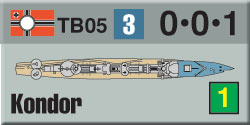 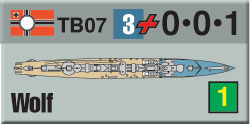
Type 1923
Known as the “Birds of Prey,” these six boats were built at Wilhelmshaven Navy Yard in the mid-1920’s. Built to a very conservative design, they carried three 105mm (4.1-inch) guns and six torpedo tubes. At just over 900 tons they really were “torpedo boats.” All saw a great deal of action during the Second World War, usually as escorts, and all had been lost by the summer of 1944.
Type 1924
Originally intended to mark a step forward in fighting power, the six “Predators” instead kept the 105mm main armament of the Type 1923 and turned in slightly better speed and range than the previous class. Five of them had been lost by early 1942, with the last boat succumbing to Allied bombs in June 1944.
Type 1935
With a new regime in charge, things changed for torpedo boat designs as well. The Type 1935 most notably had no names, instead reverting to the strict numerical sequence of the Empire’s latter decades. The first Type 1935 therefore carried the prosaic name of T1, on up to T12. In another sign of a new government, construction moved from Wilhelmshaven Navy Yard to two private firms, with Schichau, Elbing and Deschimag, Bremen each building a half-dozen of the boats.
Though the boats had a claimed displacement of 600 tons, they actually came in at just about half again as much – while retaining all the compromises in armament and machinery needed to make the lower displacement figure. They carried just one 105mm gun, though they boasted a heavier anti-aircraft array than the pre-Nazi boats and kept the six torpedo tubes.
Weak armament, poor sea-keeping, unreliable machinery and short range added up to a poor design. They entered service between late 1939 and the summer of 1940. Three survived the war to become Soviet, French and Danish reparations.
 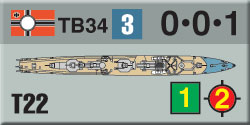
Type 1937
Having hit on a terrible compromise with the Type 1935, the Kriegsmarine doubled down by ordering nine more units of the very similar Type 1937. Some modifications to the machinery were the only noteworthy difference, and this failed to make the boats any more reliable in service.
Of the nine, five were lost in action, one was loaded with Nazi chemical weapons and scuttled in the Skaggerak to pose a grave danger generations later, and the others became French, Danish and Soviet war reparations. The French and Soviets put their pairs of 1935/1937 boats briefly into service; the Danes never bothered.
Type 1939
After the failures of the 1935/1937 boats, the Germans started over from scratch. The new “torpedo boat” design was actually a destroyer in all but name, displacing 1,200 tons standard (just slightly less than the pre-war British “G” class destroyers). They carried four 105mm guns, six torpedo tubes and a very heavy anti-aircraft array for their size. Fifteen of the boats were built at Schichau, Elbing, and thus Allied intelligence referred to them as “Elbings.” While the German designers tossed out their prior design to produce a very balanced destroyer, they retained the crapulent Wagner geared steam turbines that had plagued prior boats with their frequent breakdowns.
The first boat entered service in February 1942 and the last in December 1944. All of the class saw very active service. Four of them survived the war, with three going to the French and one to the Soviets as reparations.
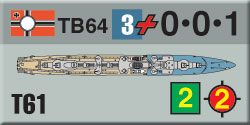 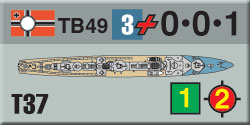
Type 1940
If Type 1939 was a smallish destroyer, Type 1940 was full-sized: 1,900 tons standard, armed with four 127mm (five-inch) guns, eight torpedo tubes and an extensive anti-aircraft array. These destroyers in all but name would be built in Dutch shipyards, which were relatively undamaged and had a skilled workforce while German yards were jammed with repair work and the effort to build huge numbers of submarines.
The design made use of machinery built for the Dutch destroyers Tjerk Hiddes and Philips van Almonde, and thus would have avoided the reliability problems of the Wagner steam turbines that powered German-made torpedo boats. Of the dozen boats ordered, only three would be launched. Towed to Germany for final outfitting, one of the three was sunk by an aerial torpedo on the way, while the others were abandoned (one at Wilhelmshaven, one at Kiel) and would later be loaded with Nazi chemical weapons and scuttled off Denmark. The other nine were destroyed on the slipways by Allied bombers.
Type 1941
An improved version of the Type 1939 boat, 15 of these were ordered from Schichau, Elbing as follow-on production to the previous class. They had more powerful machinery, but retained the unreliable Wagner high-pressure steam turbines. Otherwise they were very similar, with improved fire control and a newer model 105mm main gun (an actual dual-purpose weapon, a concept introduced to the Kriegsmarine about a decade too late). None would be completed before the war’s end, with three almost-complete boats once again used as disposal craft for chemical weapons after the war ended.
Click here to order Ships of Plan Z right now!
Gold Club members can score an extra 20 percent off.
Sign up for our newsletter right here. Your info will never be sold or transferred; we'll just use it to update you on new games and new offers.
Mike Bennighof is president of Avalanche Press and holds a doctorate in history from Emory University. A Fulbright Scholar and NASA Journalist in Space finalist, he has published a great many books, games and articles on historical subjects; people are saying that some of them are actually good.
He lives in Birmingham, Alabama with his wife and three children. He will never forget his Iron Dog, Leopold.
Want to keep Daily Content free of third-party ads? You can send us some love (and cash) through this link right here.
|
